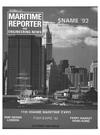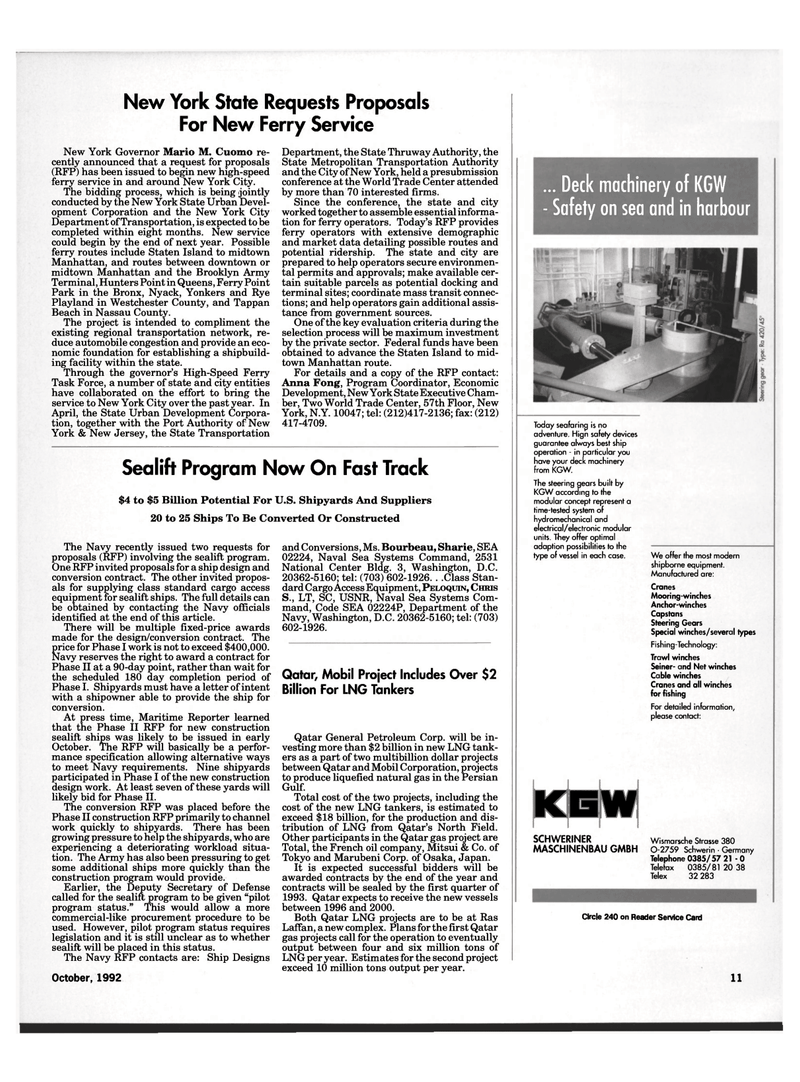
Page 9: of Maritime Reporter Magazine (October 1992)
Read this page in Pdf, Flash or Html5 edition of October 1992 Maritime Reporter Magazine
... Deck machinery of KGW - Safety on sea and in harbour
New York State Requests Proposals
For New Ferry Service
New York Governor Mario M. Cuomo re- cently announced that a request for proposals (RFP) has been issued to begin new high-speed ferry service in and around New York City.
The bidding process, which is being jointly conducted by the New York State Urban Devel- opment Corporation and the New York City
Department of Transportation, is expected to be completed within eight months. New service could begin by the end of next year. Possible ferry routes include Staten Island to midtown
Manhattan, and routes between downtown or midtown Manhattan and the Brooklyn Army
Terminal, Hunters Point in Queens, Ferry Point
Park in the Bronx, Nyack, Yonkers and Rye
Playland in Westchester County, and Tappan
Beach in Nassau County.
The project is intended to compliment the existing regional transportation network, re- duce automobile congestion and provide an eco- nomic foundation for establishing a shipbuild- ing facility within the state.
Through the governor's High-Speed Ferry
Task Force, a number of state and city entities have collaborated on the effort to bring the service to New York City over the past year. In
April, the State Urban Development Corpora- tion, together with the Port Authority of New
York & New Jersey, the State Transportation
Department, the State Thruway Authority, the
State Metropolitan Transportation Authority and the City of New York, held a presubmission conference at the World Trade Center attended by more than 70 interested firms.
Since the conference, the state and city worked together to assemble essential informa- tion for ferry operators. Today's RFP provides ferry operators with extensive demographic and market data detailing possible routes and potential ridership. The state and city are prepared to help operators secure environmen- tal permits and approvals; make available cer- tain suitable parcels as potential docking and terminal sites; coordinate mass transit connec- tions; and help operators gain additional assis- tance from government sources.
One of the key evaluation criteria during the selection process will be maximum investment by the private sector. Federal funds have been obtained to advance the Staten Island to mid- town Manhattan route.
For details and a copy of the RFP contact:
Anna Fong, Program Coordinator, Economic
Development, New York State Executive Cham- ber, Two World Trade Center, 57th Floor, New
York, N.Y. 10047; tel: (212)417-2136; fax: (212) 417-4709.
Sealift Program Now On Fast Track $4 to $5 Billion Potential For U.S. Shipyards And Suppliers 20 to 25 Ships To Be Converted Or Constructed
The Navy recently issued two requests for proposals (RFP) involving the sealift program.
One RFP invited proposals for a ship design and conversion contract. The other invited propos- als for supplying class standard cargo access equipment for sealift ships. The full details can be obtained by contacting the Navy officials identified at the end of this article.
There will be multiple fixed-price awards made for the design/conversion contract. The price for Phase I work is not to exceed $400,000.
Navy reserves the right to award a contract for
Phase II at a 90-day point, rather than wait for the scheduled 180 day completion period of
Phase I. Shipyards must have a letter of intent with a shipowner able to provide the ship for conversion.
At press time, Maritime Reporter learned that the Phase II RFP for new construction sealift ships was likely to be issued in early
October. The RFP will basically be a perfor- mance specification allowing alternative ways to meet Navy requirements. Nine shipyards participated in Phase I of the new construction design work. At least seven of these yards will likely bid for Phase II.
The conversion RFP was placed before the
Phase II construction RFP primarily to channel work quickly to shipyards. There has been growing pressure to help the shipyards, who are experiencing a deteriorating workload situa- tion. The Army has also been pressuring to get some additional ships more quickly than the construction program would provide.
Earlier, the Deputy Secretary of Defense called for the sealift program to be given "pilot program status." This would allow a more commercial-like procurement procedure to be used. However, pilot program status requires legislation and it is still unclear as to whether sealift will be placed in this status.
The Navy RFP contacts are: Ship Designs
October, 1992 and Conversions, Ms. Bourbeau, Sharie, SEA 02224, Naval Sea Systems Command, 2531
National Center Bldg. 3, Washington, D.C. 20362-5160; tel: (703) 602-1926. . .Class Stan- dard Cargo Access Equipment, PELOQUIN, CHRIS
S., LT, SC, USNR, Naval Sea Systems Com- mand, Code SEA 02224P, Department of the
Navy, Washington, D.C. 20362-5160; tel: (703) 602-1926.
Qatar, Mobil Project Includes Over $2
Billion For LNG Tankers
Qatar General Petroleum Corp. will be in- vesting more than $2 billion in new LNG tank- ers as a part of two multibillion dollar projects between Qatar and Mobil Corporation, projects to produce liquefied natural gas in the Persian
Gulf.
Total cost of the two projects, including the cost of the new LNG tankers, is estimated to exceed $18 billion, for the production and dis- tribution of LNG from Qatar's North Field.
Other participants in the Qatar gas project are
Total, the French oil company, Mitsui & Co. of
Tokyo and Marubeni Corp. of Osaka, Japan.
It is expected successful bidders will be awarded contracts by the end of the year and contracts will be sealed by the first quarter of 1993. Qatar expects to receive the new vessels between 1996 and 2000.
Both Qatar LNG projects are to be at Ras
Laffan, a new complex. Plans for the first Qatar gas projects call for the operation to eventually output between four and six million tons of
LNG per year. Estimates for the second project exceed 10 million tons output per year. hinery
Today seafaring is no adventure. Hign safety devices guarantee always best ship operation - in particular you have your deck machin from KGW.
The steering gears built by
KGW according to the modular concept represent a time-tested system of hydromechanical and electrical/electronic modular units. They offer optimal adaption possibilities to the type of vessel in each case. We offer the most modern shipborne equipment.
Manufactured are:
Cranes
Mooring-winches
Anchor-winches
Capstans
Steering Gears
Special winches/several types
Fishing-Technology:
Trawl winches
Seiner- and Net winches
Cable winches
Cranes and all winches for fishing
For detailed information, please contact:
KEW
SCHWER1NER
MASCHINENBAU GMBH Wismarsche Strasse 380 0-2759 Schwerin • Germany
Telephone 0385/57 21 -0
Telefax 0385/81 20 38
Telex 32 283
Circle 240 on Reader Service Card 11

 8
8

 10
10
